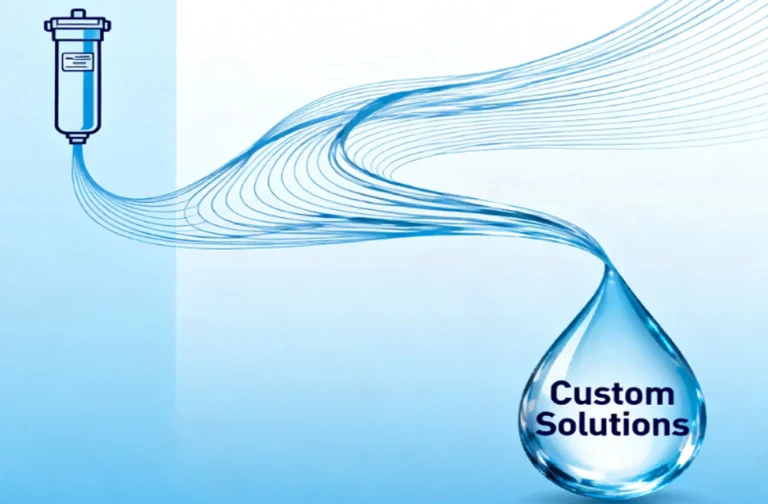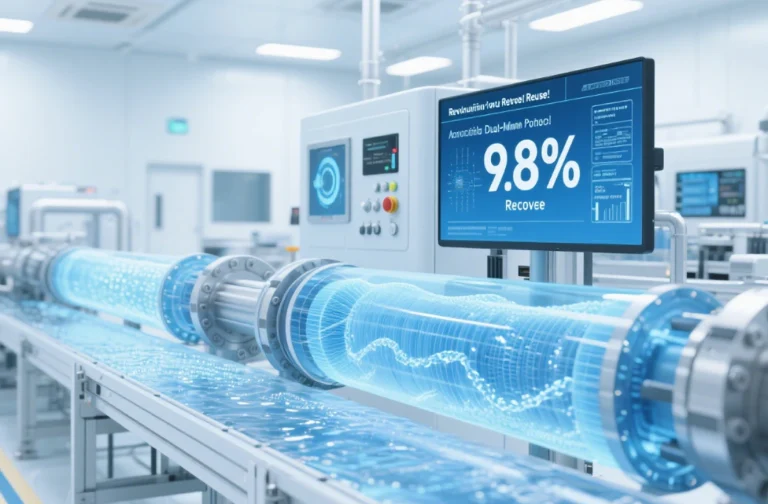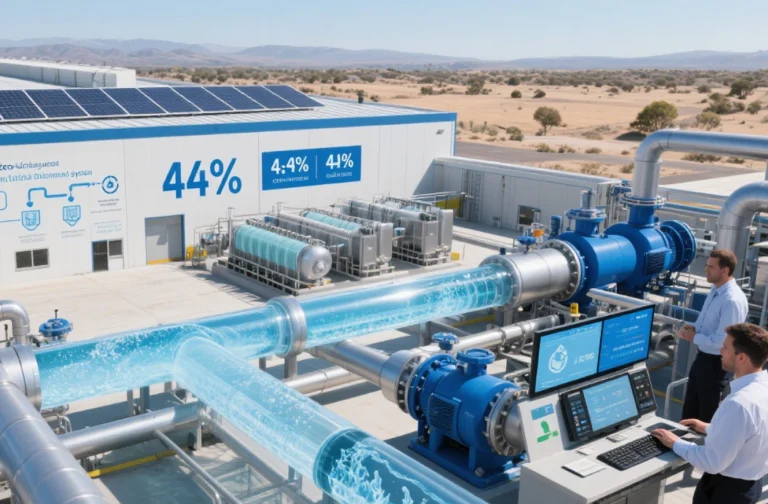BasideWT- Whole Home Water Filtration System & Replacement

Breaking Technological Barriers: Innovative Membrane and Crystallization Processes Achieve New Breakthroughs in Cost Optimization for Industrial Wastewater “Zero Liquid Discharge”
Subtitle: Successful Implementation at a Large Coal-to-Chemicals Group Project Saves Over ¥10 Million Annually in Operational Costs, Setting a New Benchmark for High-Salinity, High-COD Wastewater Treatment
Publication Date: September 4, 2024
Keywords: Industrial wastewater ZLD, high-salinity wastewater treatment, membrane water treatment, evaporation crystallization technology, wastewater reuse, ZLD technology, cost optimization, water treatment solutions, coal chemical wastewater
1. Introduction: Industry Pain Points and Our Mission
In an era of increasingly stringent environmental regulations, “Industrial Wastewater Zero Liquid Discharge” has evolved from a slogan into a mandatory standard for many high-water-consumption, high-pollution industries. However, for companies in coal-to-chemicals, pharmaceuticals, textiles, and power generation, achieving ZLD often comes with staggering costs—particularly when dealing with complex wastewater characterized by high salinity and high chemical oxygen demand (COD). While the traditional treatment train of “pretreatment → reverse osmosis → evaporation crystallization” is technologically feasible, the immense energy consumption, high chemical costs, and frequent membrane replacement and scaling maintenance render many ZLD facilities economically unsustainable. Environmental compliance becomes a heavy financial burden.
Addressing this core industry challenge head-on, our technical team has successfully integrated innovative membrane combination processes with highly efficient, energy-saving evaporation crystallization technology after years of R&D and engineering practice. This system ensures full compliance while achieving revolutionary optimization in overall operational costs. This technological system was recently successfully commissioned in a wastewater ZLD retrofit project for a large coal-to-chemicals group, with performance data far exceeding expectations, delivering significant economic and environmental benefits for the client.
2. Technical Details and Innovative Breakthroughs
The feed water for this project consisted of RO concentrate and backwash water after biological treatment, characterized by high salinity (TDS > 50,000 mg/L), high hardness, and fluctuating residual COD. Traditional processes are highly prone to membrane fouling and evaporator scaling, leading to rapid system efficiency decay.
1. Precision “Battleground” Pretreatment
Moving away from traditional blanket chemical softening, we implemented a “Dynamic Water Quality Analysis + Precision Dosing Control System”.
- Technical Details: Online monitors for hardness, alkalinity, and silica were installed at the system inlet to track real-time water quality fluctuations. The central control system dynamically adjusts the dosage of sodium hydroxide, sodium carbonate, and silica remover based on this live data, instead of using fixed doses.
- Innovative Breakthrough: This approach reduced chemical consumption by 25%-30%, simultaneously avoiding the issues of secondary pollution and scaling risks associated with over-dosing. It provided exceptionally stable feed water conditions for the subsequent membrane systems. The pretreated water fully met the inlet requirements for the membrane systems (SDI < 3, Hardness < 1 mg/L).
2. The “Efficiency Revolution” in Membrane System Combination Technology
For the core concentration phase, we abandoned traditional single-pass RO and innovatively adopted a cascading “Ultrafiltration + Disc Tube Reverse Osmosis (DTRO) + Electrodialysis (ED)” combination process.
- Technical Details:
- Ultrafiltration (UF): Served as the final barrier, removing micron-sized particles entirely.
- Disc Tube RO (DTRO): Specifically designed for high-fouling, high-salinity brine. Its open-channel design effectively prevents membrane fouling, concentrating the wastewater volume to 1/4 of its original, achieving a recovery rate of over 75%.
- Electrodialysis (ED): This was the core innovation of the project. The concentrate from DTRO was further treated with specialized ED equipment. ED utilizes ion-exchange membranes and a direct current electric field to selectively separate ions in the brine, further concentrating it to a TDS exceeding 150,000 mg/L and increasing the overall water recovery rate to over 95%.
- Innovative Breakthrough: The use of ED drastically reduced the treatment load on the terminal evaporator. The evaporator is the system’s “energy giant”; reducing its load by 60% directly translates to a proportional decrease in steam usage and power consumption, which is the key to cost optimization.
3. “Intelligent Energy Reduction” in the Evaporation Crystallization System
For the final minimal concentrate volume, a high-efficiency Mechanical Vapor Recompression (MVR) evaporator was selected.
- Technical Details: MVR technology compresses the secondary vapor generated by evaporation, increasing its temperature and pressure before recycling it as the primary heat source, eliminating the need for external fresh steam and requiring only minimal electricity to drive the compressor.
- Innovative Breakthrough: Leveraging the significant volume reduction from the upstream ED, we equipped the MVR with a variable frequency drive (VFD) system. This allows the compressor speed to auto-adjust based on real-time feed flow, avoiding the energy waste of “over-sizing.” The system also integrates an automatic online cleaning function, which intelligently detects scaling trends based on pressure differential and temperature changes and initiates short cleaning cycles, maintaining continuous high heat exchange efficiency and preventing energy consumption increases due to scaling.
3. Speaking with Data: Exceptional Project Results
After stable operation for one quarter, third-party audit data confirmed the following impressive results:
- Effluent Quality: All produced water was reused in the production cycle’s cooling water system, fully meeting quality standards; crystallized salts met the requirements of the “Identification Standards for Hazardous Waste,” clarifying the path for subsequent resource utilization.
- Economic Indicators:
- Overall System Energy Consumption Reduction: Reduced by 40% compared to traditional ZLD processes.
- Chemical Cost Reduction: The precision dosing system saved 28% on chemical costs.
- Operational Cost Savings: Comprehensive calculations show annual operational and maintenance cost savings for the client exceeding RMB 12 million.
- Return on Investment (ROI): Despite the initial investment in ED and other technologies, the massive energy savings are projected to shorten the payback period to just 3.5 years.
- Environmental & Social Benefits: The project enables the annual reduction and reuse of over one million tons of saline wastewater, completely eliminating environmental risk and significantly enhancing the company’s social reputation.
4. Industry Impact and Future Outlook
The success of this project is not just a victory of a single technology but a success of a systematic and precise design philosophy. It proves that through technological innovation and process optimization, environmental protection and economic benefits can be perfectly balanced,彻底打破了“零排放即高成本”的行业魔咒 (shattering the industry myth that “ZLD equates to high cost”).
Our Chief Technology Officer stated, “‘Zero Liquid Discharge’ should not be a ‘bottomless pit’ of cost for enterprises. Our mission is to provide sustainable solutions that are ‘affordable and effective’ for our clients through smarter, more efficient technology combinations. The technological model of this project is highly replicable and adaptable, suitable for widespread application in flue gas desulfurization wastewater from power plants, produced water from petroleum extraction, wastewater from advanced materials manufacturing, and other fields.”
5. Conclusion
Facing intensifying market competition and environmental pressures, cost reduction and efficiency improvement are perpetual themes for enterprises. The successful implementation of this coal-to-chemicals wastewater ZLD project marks another significant achievement for our company in the high-end water treatment technology sector and provides a highly valuable reference model for peers. We firmly believe that only through continuous innovation and deep technological exploration can we create irreplaceable value for our clients and jointly promote the harmonious development of industry and the water environment.
If high costs associated with high-salinity wastewater treatment are challenging your operations, please contact our team of experts for a tailored technical proposal and cost-benefit analysis. Let’s use technology to unlock the dual achievements of environmental protection and profitability for your enterprise.




